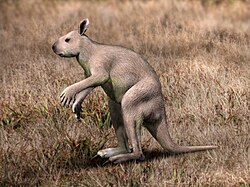Sthenurus
|
Sthenurus Temporal range: Pleistocene |
|
|---|---|
 |
|
| S. stirlingi | |
| Scientific classification | |
| Kingdom: | Animalia |
| Phylum: | Chordata |
| Class: | Mammalia |
| Infraclass: | Marsupialia |
| Order: | Diprotodontia |
| Family: | Macropodidae |
| Subfamily: | Sthenurinae |
| Genus: |
†Sthenurus (Owen, 1873a) |
| Paleospecies | |
|
|
Sthenurus ("strong tail") is an extinct genus of kangaroo. With a length of about 3 m (10 ft), some species were twice as large as modern extant species. Sthenurus was related to the better-known Procoptodon. The subfamily Sthenurinae is believed to have separated from its sister taxon, the Macropodinae (kangaroos and wallabies), halfway through the Miocene and then its population grew during the Pliocene.
Research by Darren R. Gröcke from Monash University, analysed the diets of fauna at various fossil site localities in South Australia, using stable carbon isotope analysis 13C/12C of collagen. He found that at older localities like Cooper Creek the species of Sthenurus were adapted to a diet of leaves and twigs (browsing). This was due to the wet climate of the time period between 132,000-108,000 years (TL and uranium dating), which allowed for a more varied vegetation cover.
At the Baldina Creek fossil site 30,000 years (C14 dating), the genus had transitioned to a diet of grass-grazing. During this time, the area was open grasslands with sparse tree cover as the continent was drier than today. But at Dempsey's Lake (36-25,000 years) and Rockey River (19,000 C14 dating), their diet was of both grazing and browsing. This analysis may be because of a wetter climatic period. The overall anatomy of the genus did not alter in response to the change in diet and dentition did not adapt to the varying toughness of the vegetation between grasses, shrubs and trees.
Other animals found in the Cuddie Springs habitat include the flightless bird Genyornis, the red kangaroo, Diprotodon, humans and many others.
...
Wikipedia
